plug MITSUBISHI MIRAGE G4 2020 Owner's Manual (in English)
[x] Cancel search | Manufacturer: MITSUBISHI, Model Year: 2020, Model line: MIRAGE G4, Model: MITSUBISHI MIRAGE G4 2020Pages: 253, PDF Size: 36.39 MB
Page 150 of 253
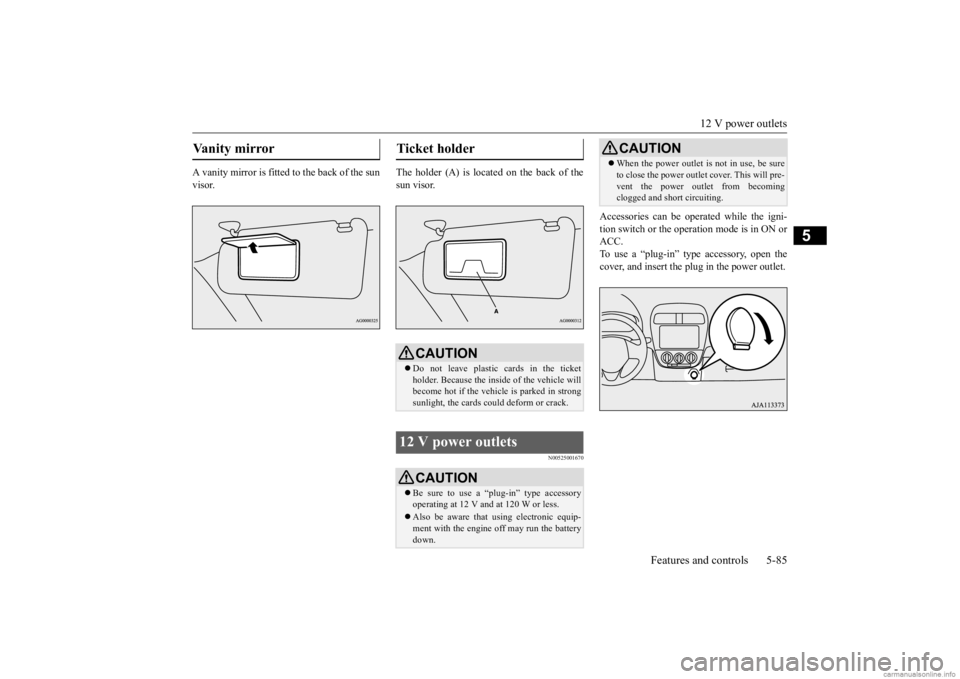
12 V power outlets
Features and controls 5-85
5
A vanity mirror is fitted to the back of the sun visor.
The holder (A) is located on the back of the sun visor.
N00525001670
Accessories can be operated while the igni- tion switch or the operation mode is in ON or ACC.To use a “plug-in” type accessory, open the cover, and insert the
plug in the power outlet.
Vanity mirror
Ticket holder
CAUTIONDo not leave plastic cards in the ticket holder. Because the insi
de of the vehicle will
become hot if the vehicle is parked in strong sunlight, the cards c
ould deform or crack.
12 V power outlets
CAUTIONBe sure to use a “plug-in” type accessory operating at 12 V and at 120 W or less. Also be aware that
using electronic equip-
ment with the engine
off may run the battery
down.
When the power outlet is not in use, be sure to close the power outlet cover. This will pre-vent the power out
let from becoming
clogged and short circuiting.CAUTION
BK0284300US.book 85 ページ 2019年5月23日 木曜日 午後12時22分
Page 177 of 253
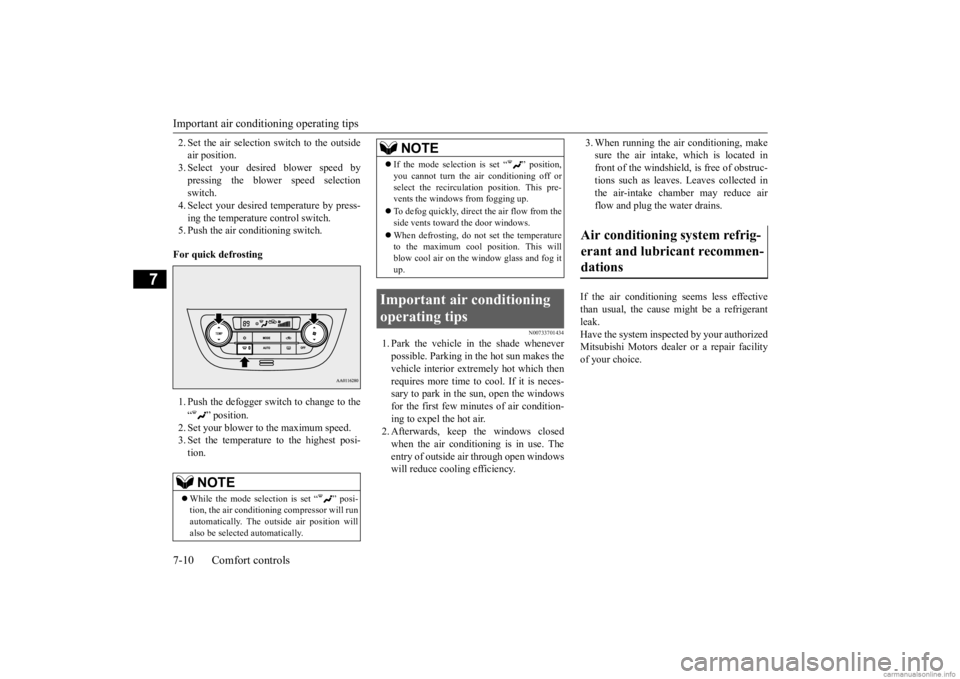
Important air condit
ioning operating tips
7-10 Comfort controls
7
2. Set the air selection switch to the outside air position.3. Select your desired blower speed by pressing the blower speed selection switch.4. Select your desired temperature by press- ing the temperature control switch. 5. Push the air conditioning switch. For quick defrosting 1. Push the defogger switch to change to the “ ” position. 2. Set your blower to the maximum speed.3. Set the temperature to the highest posi- tion.
N00733701434
1. Park the vehicle in the shade whenever possible. Parking in the hot sun makes the vehicle interior extremely hot which then requires more time to cool. If it is neces-sary to park in the sun, open the windows for the first few minutes of air condition- ing to expel the hot air.2. Afterwards, keep the windows closed when the air conditioning is in use. The entry of outside air through open windowswill reduce cooling efficiency.
3. When running the air conditioning, make sure the air intake, which is located infront of the windshield, is free of obstruc- tions such as leaves. Leaves collected in the air-intake chamber may reduce airflow and plug the water drains.
If the air conditioning seems less effective than usual, the cause might be a refrigerant leak. Have the system inspected by your authorizedMitsubishi Motors dealer
or a repair facility
of your choice.
NOTE
While the mode selection is set “ ” posi- tion, the air conditioning
compressor will run
automatically. The out
side air position will
also be selected automatically.
If the mode selection is set “ ” position, you cannot turn the air conditioning off orselect the recirculati
on position. This pre-
vents the windows from fogging up. To defog quickly, direct the air flow from the side vents toward the door windows. When defrosting, do not set the temperature to the maximum cool position. This will blow cool air on the window glass and fog it up.
Important air conditioning operating tips
NOTE
Air conditioning system refrig- erant and lubricant recommen- dations
BK0284300US.book 10 ページ 2019年5月23日 木曜日 午後12時22分
Page 200 of 253
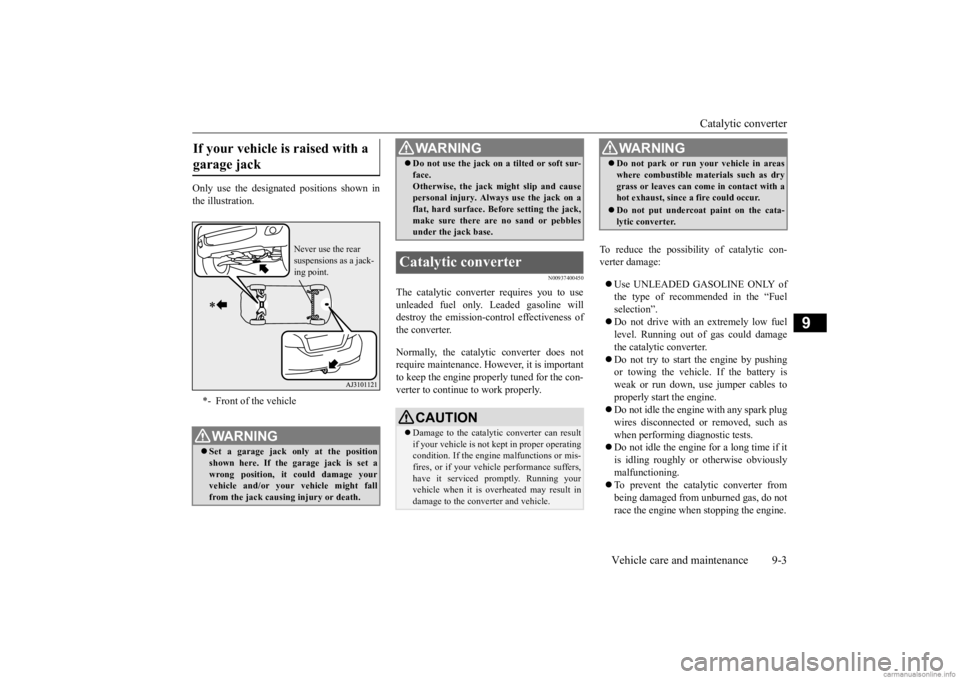
Catalytic converter
Vehicle care and maintenance 9-3
9
Only use the designated positions shown in the illustration.
N00937400450
The catalytic converter requires you to use unleaded fuel only. Leaded gasoline willdestroy the emission-control effectiveness of the converter. Normally, the
catalytic converter does not
require maintenance. Ho
wever, it is important
to keep the engine properly tuned for the con- verter to continue to work properly.
To reduce the possibili
ty of catalytic con-
verter damage: Use UNLEADED GASOLINE ONLY of the type of recommended in the “Fuel selection”. Do not drive with an extremely low fuel level. Running out of gas could damage the catalytic converter. Do not try to start the engine by pushing or towing the vehicle. If the battery is weak or run down, use jumper cables to properly start the engine. Do not idle the engine with any spark plug wires disconnected or
removed, such as
when performing diagnostic tests. Do not idle the engine for a long time if it is idling roughly or otherwise obviously malfunctioning. To prevent the catalytic converter from being damaged from unburned gas, do not race the engine when stopping the engine.
If your vehicle is raised with a garage jack *- Front of the vehicleWA R N I N G Set a garage jack only at the position shown here. If the gar
age jack is set a
wrong position, it could damage your vehicle and/or your
vehicle might fall
from the jack causing injury or death.
Never use the rear suspensions as a jack-ing point.
Do not use the jack on a tilted or soft sur- face.Otherwise, the jack might slip and causepersonal injury. Always
use the jack on a
flat, hard surface. Before setting the jack, make sure there are no sand or pebblesunder the jack base.
Catalytic converter
CAUTION Damage to the catalytic
converter can result
if your vehicle is not
kept in proper operating
condition. If the engine
malfunctions or mis-
fires, or if your vehi
cle performance suffers,
have it serviced
promptly. Running your
vehicle when it is ove
rheated may result in
damage to the conve
rter and vehicle.
WA R N I N G
WA R N I N GDo not park or run your vehicle in areas where combustible materials such as drygrass or leaves can come
in contact with a
hot exhaust, since a fire could occur. Do not put undercoat paint on the cata- lytic converter.
BK0284300US.book 3 ページ 2019年5月23日 木曜日 午後12時22分
Page 219 of 253
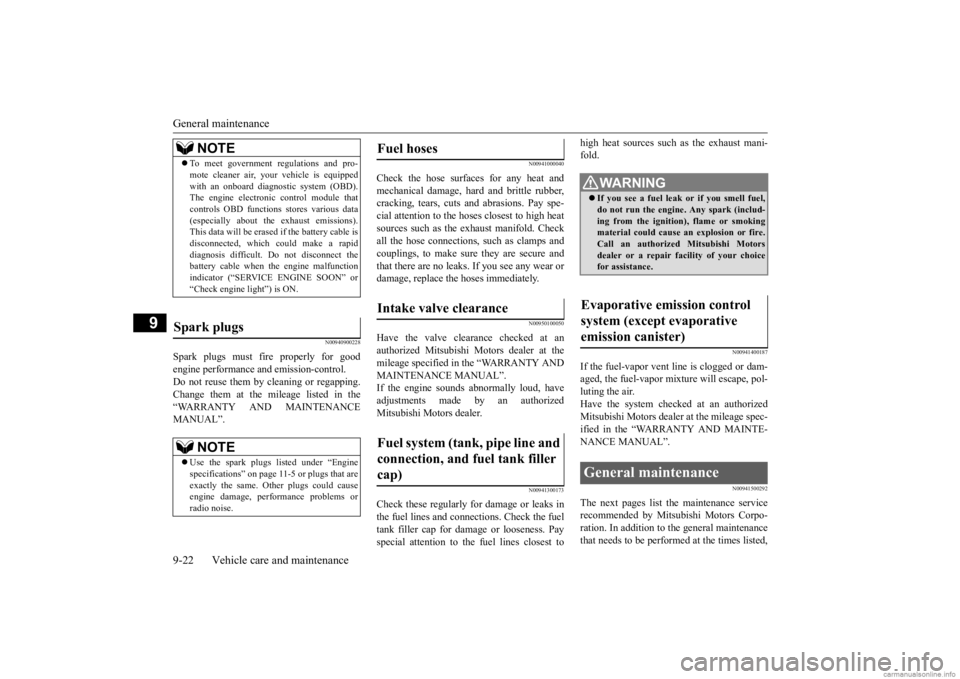
General maintenance 9-22 Vehicle care and maintenance
9
N00940900228
Spark plugs must fire properly for good engine performance
and emission-control.
Do not reuse them by cleaning or regapping.Change them at the mileage listed in the “WARRANTY AND MAINTENANCE MANUAL”.
N00941000040
Check the hose surfaces for any heat and mechanical damage, hard and brittle rubber, cracking, tears, cuts and abrasions. Pay spe-cial attention to the hos
es closest to high heat
sources such as the exhaust manifold. Check all the hose connections
, such as clamps and
couplings, to make sure
they are secure and
that there are no leaks. If you see any wear or damage, replace the
hoses immediately.
N00950100050
Have the valve clearance checked at an authorized Mitsubishi Motors dealer at the mileage specified in the “WARRANTY AND MAINTENANCE MANUAL”.If the engine sounds abnormally loud, have adjustments made by an authorized Mitsubishi Motors dealer.
N00941300173
Check these regularly for damage or leaks in the fuel lines and connections. Check the fuel tank filler cap for dama
ge or looseness. Pay
special attention to the fuel lines closest to
high heat sources such
as the exhaust mani-
fold.
N00941400187
If the fuel-vapor vent line is clogged or dam-aged, the fuel-vapor mixture will escape, pol- luting the air. Have the system checked at an authorizedMitsubishi Motors dealer at the mileage spec- ified in the “WARRANTY AND MAINTE- NANCE MANUAL”.
N00941500292
The next pages list th
e maintenance service
recommended by Mitsubishi Motors Corpo-ration. In addition to the general maintenance that needs to be performed at the times listed,
NOTE
To meet government regulations and pro- mote cleaner air, your
vehicle is equipped
with an onboard dia
gnostic system (OBD).
The engine electronic control module that controls OBD functions stores various data (especially about th
e exhaust emissions).
This data will be erased if the battery cable is disconnected, which could make a rapid diagnosis difficult.
Do not disconnect the
battery cable when the engine malfunction indicator (“SERVICE ENGINE SOON” or “Check engine
light”) is ON.
Spark plugs
NOTE
Use the spark plugs listed under “Engine specifications” on page 11
-5 or plugs that are
exactly the same. Other plugs could cause engine damage, performance problems orradio noise.
Fuel hoses Intake valve clearance Fuel system (tank, pipe line and connection, and fuel tank filler cap)
WA R N I N G If you see a fuel leak
or if you smell fuel,
do not run the engine. Any spark (includ- ing from the ignition
), flame or smoking
material could cause an explosion or fire.Call an authorized Mitsubishi Motors dealer or a repair fa
cility of your choice
for assistance.
Evaporative emission control system (except evaporative emission canister) General maintenance
BK0284300US.book 22 ページ 2019年5月23日 木曜日 午後12時22分
Page 244 of 253
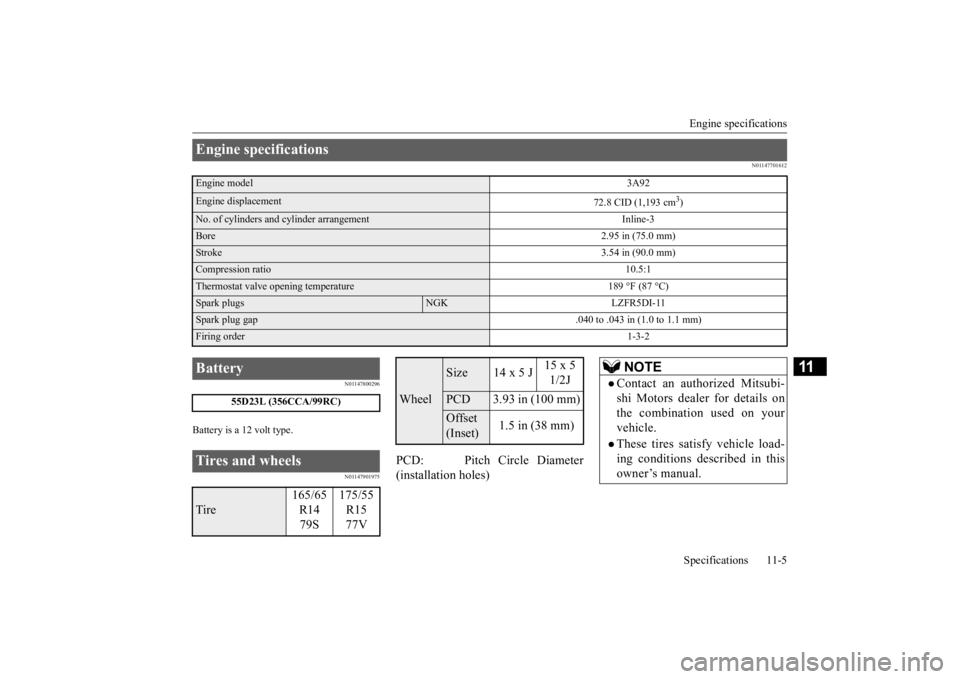
Engine specifications Specifications 11-5
11
N01147701612
N01147800296
Battery is a 12 volt type.
N01147901975
PCD: Pitch Circle Diameter (installation holes)
Engine specifications Engine model
3A92
Engine displacement
72.8 CID (1,193 cm
3)
No. of cylinders and cyli
nder arrangement Inline-3
Bore
2.95 in (75.0 mm)
Stroke
3.54 in (90.0 mm)
Compression ratio
10.5:1
Thermostat valve opening temperature 189 °F (87 °C)Spark plugs
NGK LZFR5DI-11
Spark plug gap .040 to .043 in (1.0 to 1.1 mm)Firing order
1-3-2
Battery
55D23L (356CCA/99RC)
Tires and wheels Tire
165/65 R14 79S
175/55 R15 77V
Wheel
Size 14 x 5 J
15 x 5 1/2J
PCD 3.93 in (100 mm)Offset (Inset)
1.5 in (38 mm)
NOTE
Contact an authorized Mitsubi- shi Motors dealer for details onthe combination used on your vehicle.These tires satisfy vehicle load-ing conditions d
escribed in this
owner’s manual.
BK0284300US.book 5 ページ 2019年5月23日 木曜日 午後12時22分
Page 249 of 253
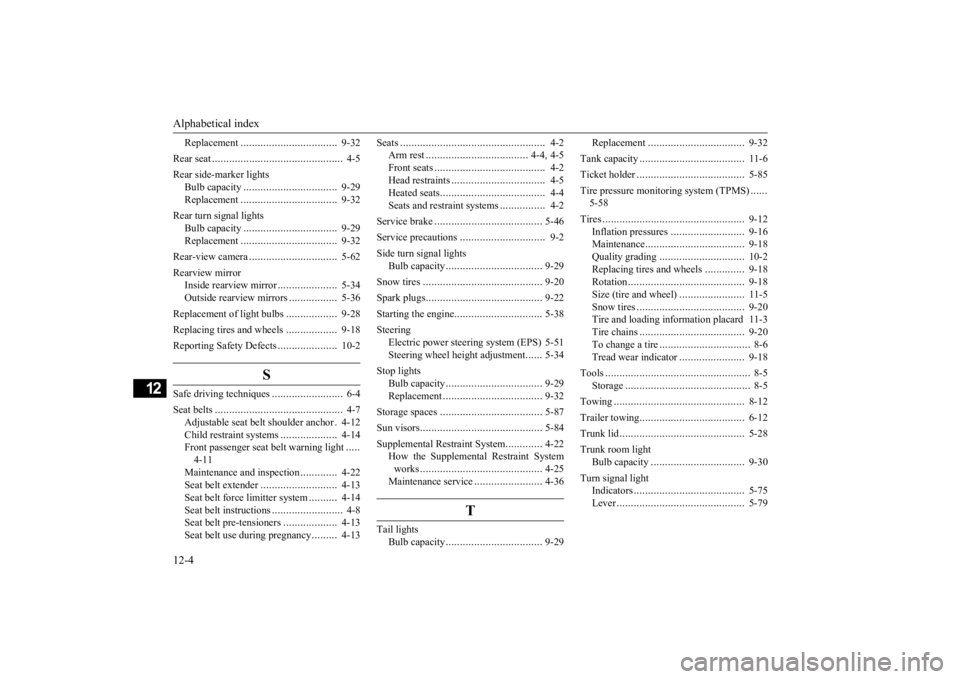
Alphabetical index 12-4
12
Replacement
..................................
9-32
Rear seat
..............................................
4-5
Rear side-marker lights
Bulb capacity
.................................
9-29
Replacement
..................................
9-32
Rear turn signal lights
Bulb capacity
.................................
9-29
Replacement
..................................
9-32
Rear-view camera
...............................
5-62
Rearview mirror
Inside rearview mirror
.....................
5-34
Outside rearview mirrors
.................
5-36
Replacement of light bulbs
..................
9-28
Replacing tires and wheels
..................
9-18
Reporting Safety Defects
.....................
10-2
S
Safe driving techniques
.........................
6-4
Seat belts
.............................................
4-7
Adjustable seat belt shoulder anchor
.4-12
Child restraint systems
....................
4-14
Front passenger seat belt warning light
.....
4-11 Maintenance and inspection
.............
4-22
Seat belt extender
...........................
4-13
Seat belt force limitter system
..........
4-14
Seat belt
instructions
.........................
4-8
Seat belt pr
e-tensioners
...................
4-13
Seat belt use
during pregnancy
.........
4-13
Seats
...................................................
4-2
Arm rest
....................................
4-4
, 4-5
Front seats
.......................................
4-2
Head restraints
.................................
4-5
Heated seats
.....................................
4-4
Seats and restraint systems
................
4-2
Service brake
......................................
5-46
Service precautions
..............................
9-2
Side turn signal lights
Bulb capacity
..................................
9-29
Snow tires
..........................................
9-20
Spark plugs
.........................................
9-22
Starting the engine
...............................
5-38
Steering
Electric power stee
ring system (EPS) 5-51
Steering wheel height adjustment
......
5-34
Stop lights
Bulb capacity
..................................
9-29
Replacement
...................................
9-32
Storage spaces
....................................
5-87
Sun visors
...........................................
5-84
Supplemental Re
straint System
.............
4-22
How the Supplemental Restraint System works
...........................................
4-25
Maintenance service
........................
4-36
T
Tail lights
Bulb capacity
..................................
9-29
Replacement
..................................
9-32
Tank capacity
.....................................
11-6
Ticket holder
......................................
5-85
Tire pressure moni
toring system (TPMS)
......
5-58 Tires
..................................................
9-12
Inflation pressures
..........................
9-16
Maintenance
...................................
9-18
Quality grading
..............................
10-2
Replacing tires and wheels
..............
9-18
Rotation
.........................................
9-18
Size (tire and wheel)
.......................
11-5
Snow tires
......................................
9-20
Tire and loading information placard 11-3 Tire chains
.....................................
9-20
To change a tire
................................
8-6
Tread wear indicator
.......................
9-18
Tools
...................................................
8-5
Storage
............................................
8-5
Towing
..............................................
8-12
Trailer towing
.....................................
6-12
Trunk lid
............................................
5-28
Trunk room light
Bulb capacity
.................................
9-30
Turn signal light
Indicators
.......................................
5-75
Lever
.............................................
5-79
BK0284300US.book 4 ページ 2019年5月23日 木曜日 午後12時22分